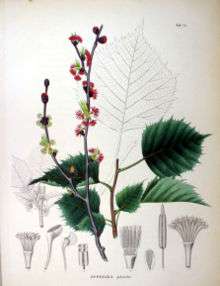Euptelea
Euptelea is a genus of two species[2] of flowering plants in the monogeneric family Eupteleaceae. The genus is found from Assam east through China to Japan, and consists of shrubs or small trees:
- Euptelea pleiosperma
- Euptelea polyandra
| Euptelea | |
|---|---|
 | |
| Euptelea polyandra | |
| Scientific classification | |
| Kingdom: | Plantae |
| Clade: | Tracheophytes |
| Clade: | Angiosperms |
| Clade: | Eudicots |
| Order: | Ranunculales |
| Family: | Eupteleaceae K.Wilh.[1] |
| Genus: | Euptelea Siebold & Zucc. |
| Species | |
| |
The genus was previously placed in the family Trochodendraceae, but the family Eupteleaceae has been recognized by many taxonomists. The APG IV system (2016;[1] unchanged from the APG III system of 2009,[3] the APG II system of 2003 and the APG system of 1998), recognizes it and places it in the order Ranunculales, in the clade eudicots. The family consists of a single genus Euptelea, with two species, native to eastern Asia.
Euptelea polyandra is used as a food plant by the larvae of some Lepidoptera species including the engrailed.
The flowers lack sepals and petals. The anthers are basifixed, and the leaves are arranged in whorls.[4]
References
- Angiosperm Phylogeny Group (2016). "An update of the Angiosperm Phylogeny Group classification for the orders and families of flowering plants: APG IV". Botanical Journal of the Linnean Society. 181 (1): 1–20. doi:10.1111/boj.12385. ISSN 0024-4074.CS1 maint: uses authors parameter (link)
- Christenhusz, M. J. M.; Byng, J. W. (2016). "The number of known plants species in the world and its annual increase". Phytotaxa. 261 (3): 201–217. doi:10.11646/phytotaxa.261.3.1.
- Angiosperm Phylogeny Group (2009), "An update of the Angiosperm Phylogeny Group classification for the orders and families of flowering plants: APG III", Botanical Journal of the Linnean Society, 161 (2): 105–121, doi:10.1111/j.1095-8339.2009.00996.x, archived from the original on 2017-05-25, retrieved 2010-12-10
- Yi Ren, Hong-Fang Li, Liang Zhao, and Peter K. Endress. 2007. "Floral Morphogenesis in Euptelea (Eupteleaceae, Ranunculales)." Annals of Botany 100(2):185-193. (see "External links" below).
| Wikimedia Commons has media related to Euptelea. |
External links
- Floral Morphology in Euptelea doi:10.1093/aob/mcm106
- Eupteleaceae in L. Watson and M.J. Dallwitz (1992 onwards). The families of flowering plants.
- Flora of China: Eupteleaceae
- NCBI Taxonomy Browser
- links at CSDL, Texas